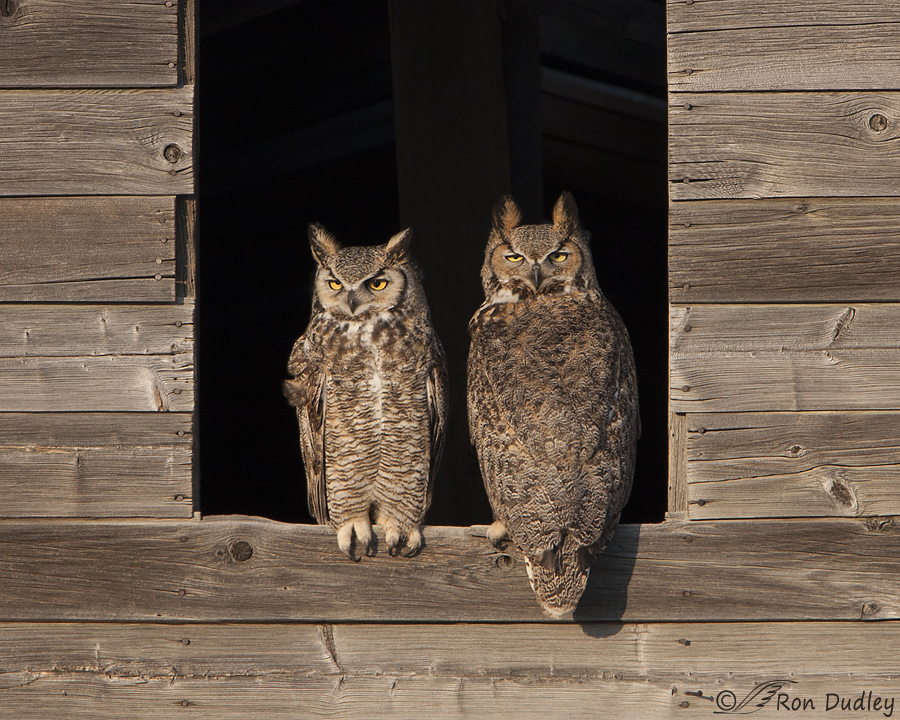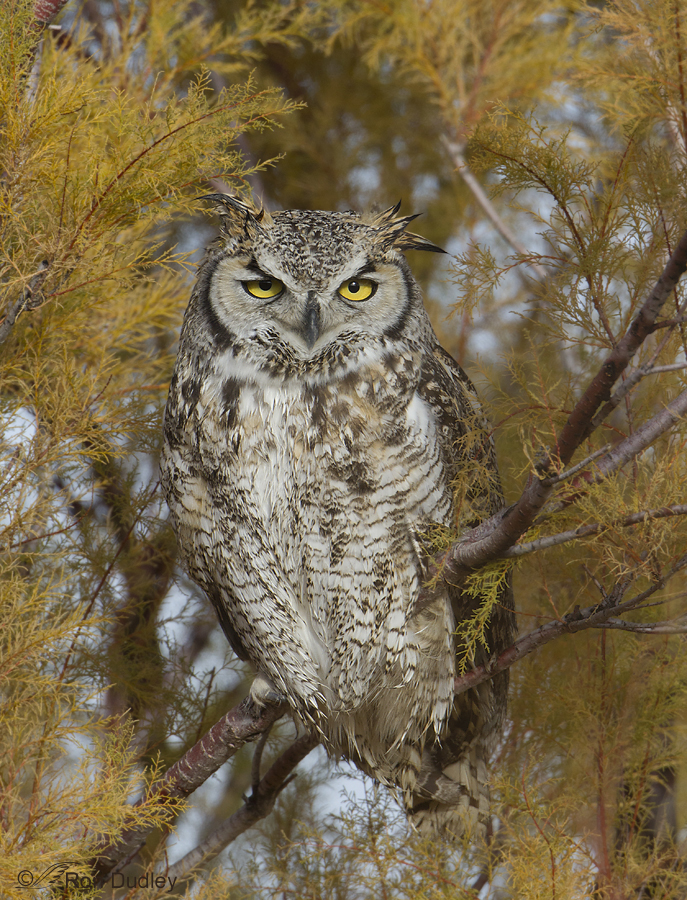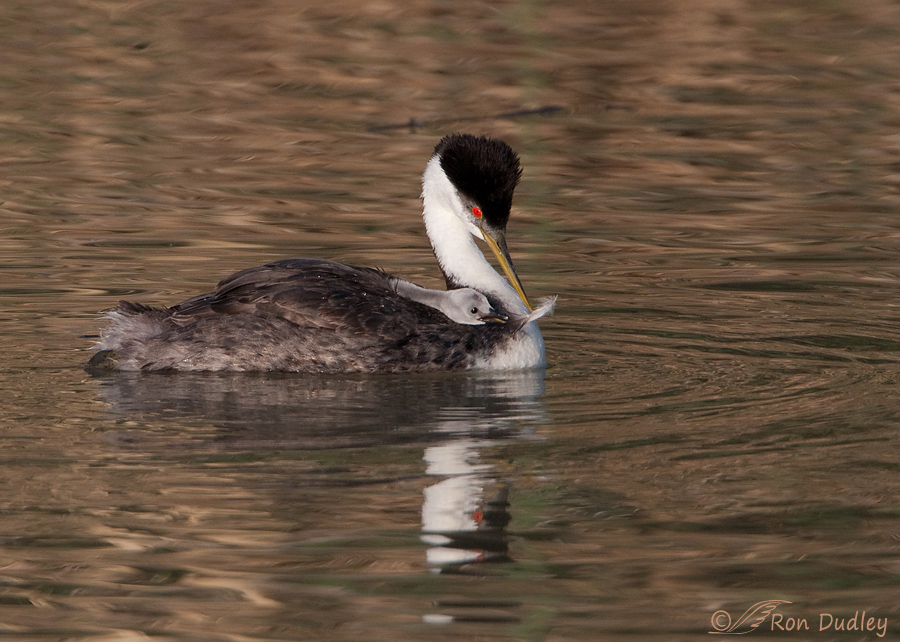I’ve spent a lot of time over the years watching owls – Great Horned, Burrowing and Short-eared especially and I’ve never seen one eating its own feathers.

I’ve probably spent more time with Great Horned Owls than any other owl species – especially the birds on the Montana family farm where I grew up. This is the mated pair that has been there for years.

But I’ve also photographed them here in Utah as in this bird on Antelope Island. I’ve watched them sleep and groom and eat and do most of the normal activities you might expect of them. But I’ve never seen one swallow a feather.

The only group of birds that I’m aware of that regularly eats feathers is grebes. I’ve documented Western, Clark’s and Pied-billed Grebes swallowing them. Even the hatchlings eat feathers as you can see here.
This is a behavior that I’ve not only never seen in owls, it’s something I’ve never observed in any species of raptor. So I was fascinated recently when fellow bird photographer Daniel Dietrich sent me the following video clip of a Great Horned Owl doing just that – eating one of its own feathers. He’d seen some of my posts about grebes eating feathers and wondered if I knew anything about the behavior in owls. I don’t but just because the behavior is new to me doesn’t necessarily mean it’s all that unusual.
Here’s the link to Daniel’s clip. It’s definitely worth watching if you have any interest at all in owl behavior. This is not a small feather and the owl has some difficulty getting and keeping it down but eventually it succeeds. It must have really wanted to eat that feather.
Daniel and I would both love to get any feedback from anyone who might know how common this behavior is in Great Horned Owls in particular or in any other raptors. Has anyone ever seen it? Does anyone know what the function/purpose of such a behavior might be in owls? The function is known in grebes (a dietary aid to keep fish bones in the stomach long enough to be digested and it helps in controlling digestive parasites) but it must be something different in owls.
Any thoughts or info would be appreciated by us both.
Ron


Such beautiful images, Ron!!!
Thank you, Lois.
Then again, owls are not the most thoughtful creatures among us, but they are often persistent. Maybe once that feather was in it’s mouth it just sort of seemed like eating was the thing to do. “Humm… haven’t eaten anything with feathers in a while….num, num, num.” I find it interesting how hard the bird worked at getting down the thick part of the shaft. That’s got to be prickly at best!
Your top photo shows how easily owls can get there heads on backwards!
Thank you!
Agreed, Mikal – that owl was dead-set on swallowing that awkward and uncomfortable mouthful, obviously not an easy task.
When they eat their prey, some have feathers that get eaten alongside the meat, so I assume swallowing a feather wouldn’t be too far from the realm of possibility since the owl has eaten them before. We once had an owl sit on the ground beside our house in the daytime. I knew something was wrong and finally found a wildlife rehabilitation center willing to come to our house. The owl was gently picked up by the handler and examined. He said he sees this often, owls flying into electricity wires and losing their sense of balance and unable to fly. I happily wrote a check to his center and the owl was able to be released several months later. It does my heart good to see owls, but only in the wild.
Dana, BNA says that feathers are often found in their pellets from eating avian prey. Not sure though how well that translates into deliberately eating their own feathers, particularly a large one like this. Delighted to hear that your injured owl recovered.
Hooray. An owlfest. All my Christmases are coming at once – and early.
Thank you for the glorious images, and Daniel for that fascinating video.
And a thank you to all the commentators who are more knowledgeable, but no less appreciative than I am.
Well said, EC!
Hi Ron,
This is fascinating behavior to watch. Louise Shimmel from Cascades Raptor Center asked if I had any comments about this. I have never heard of this behavior before and I admit that I can only make a guess about this. One possibility that occurs to me is that this is just a strange behavior of one individual owl. Our cat will pull out a wad of loose fur and instead of discarding it, she proceeds to swallow it. Maybe the owl is simply doing the same thing, and no particular benefit is obtained from doing so. However, just like grebes, there may be a similar benefit. Great Horned Owls will eat just about anything from voles to skunks (often a favorite). Many of these birds also wade into shallow water to catch crayfish and even fish. Perhaps this bird does this on a regular basis and has discovered that a cushion of feathers in the stomach is helpful. (I can’t explain how it would have discovered this, however.) These are the only guesses that I can come up with at the moment and would love to know if anyone else has seen this behavior before. I can’t think of any other benefit to eating feathers. Feathers are mostly just keratin (a protein) with very little, if any calcium, so they would not be eating feathers to obtain calcium. Additionally, calcium would be very poorly absorbed in an owl’s stomach. The pH of an owl’s stomach is not very acidic, as it is in other raptors. Thus, owls regurgitate a pellet containing bones of the prey. In other raptors, the stomach (actually, the proventriculus, or fore-stomach) is very, very acidic and bones are completely dissolved. With a pH closer to neutral, calcium is less easily absorbed in many of its forms.
Dan Gleason
Thank you very much, Dan. I respect your experience with birds and your knowledge – your input is very much appreciated! I’ll make sure Daniel sees this too. I think it’s a fascinating clip and an interesting response from you!
I have actually seen barn owls eating their own feathers, as well as the egg shells from their hatchlings. I am sure it helps with the calcium and the digestive process as well. Since owls are mostly nocturnal, I am sure it is rare for you to see but probably more common than you think!
That’s the kind of feedback I was hoping for, Kathryn. Thank you. BNA says about Barn Owls “Shells are either pushed aside and trampled into nest lining or eaten by female”
Actually, I didn’t know how common or uncommon the feather eating behavior might be. Still don’t, really…
This is such a beautiful couple. I have seen female owls eat feathers once in a while and usually during egg laying. Feathers contain some calcium and I read somewhere that they will eat their own feather to get the calcium it provides. They can’t digest the actual feather and it will come back out as a pellet. That is the only reason GHO’s and Barn Owl females would eat a feather that I know of. Good luck to this pair as egg laying season is almost here.
Interesting possibility, Debbie, I hadn’t thought of that. In fact I didn’t know there was any significant amount of calcium in feathers – I just always thought of feathers as protein (keratin) and sulfur (thus the nasty smell when feathers, hair or fingernails burn). I’m not sure when Daniel shot this video (pre-nesting season?) or even if the bird is a female.
I have very limited knowledge about birds, but this is the first time I am seeing(and learning)about it. Both of your Owl photos are very good. They seem to show some kind of attitude! About the pair in your Montana farm, have you seen their owlets? If you have ever photographed them, will you please share here?
Thank you again Ron for the pictures and information!
Rima, I’ve published several posts featuring owlets from this pair. Here’s one of them.
https://www.featheredphotography.com/blog/2014/02/03/great-horned-owl-chicks-on-the-farm/
Awww… Thank you Ron!!!
Since you’re so appreciative of them, Rima, here’s a couple more. Enjoy:
https://www.featheredphotography.com/blog/2013/07/16/a-wet-winking-great-horned-owl-fledgling/
https://www.featheredphotography.com/blog/2013/10/25/sleepy-great-horned-owl-fledgling/
Fantastic shots Ron. We watched a female Great Horned raise 3 Owlets two years ago. The Male Owl would show up now and then in another tree. Tree trimmers came and butchered the tree the female had used for years. The nest was gone, and the tree sat back off of the road. They shouldn’t have even touched that tree. It was so upsetting. Not sure where the Owls went to. I have always appreciated Great Horned Owls. Beautiful birds. The Grebe picture is not only beautiful, but sweet. Have a wonderful Holiday!!
The same thing happened to the tamarisks that the owl in the second photo was roosting in, Jean – park personnel cut them down, presumably because they’re invasive. Gotta admit though that I miss having them there as there aren’t many trees or large shrubs on the island. I suspect many birds miss them too.
Sensational shots Ron! Thanks for sharing.
Charlotte
Thank you, Charlotte.